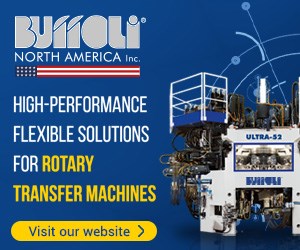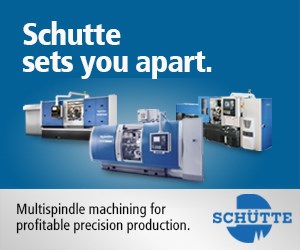Historically, rotary transfer machines have been tooled to run specific jobs for extended periods of time. These might drop complete parts such as automotive, hydraulic or pneumatic fittings every few seconds. That said, builders of these machines are building flexibility into their designs to enable faster changeovers to new jobs. While still well-suited for high-volume production, new models can more readily accommodate smaller batch sizes.
Multistation rotary transfer machines move parts installed on an indexing vertical or horizontal table from one machining station to another. Different operations are performed at each station until the part is completed. The number of stations depends on the machine model. If there are eight clamping positions on the table, the first position is used for loading and the other seven positions can each perform multiple operations on a part. As the table rotates incrementally, each part moves to another workstation where machining operations are performed on as many as three sides of the part. The combination of automated part feeding and simultaneous machining operations is why a rotary transfer machine can produce an abundance of parts quickly. The overall cycle time is determined by how long it takes to complete the slowest operation.
Sema Technology Group has a number of models within its Multi Transfer (MT) series. The C-Series transfer machines operate from a pallet clamping system in which workpieces can be processed in stationary or rotating mode and continuously positioned. They can be clamped as needed using a three-jaw chuck, collet or mandrel. The flexible modular design is said to enable both the complex processing of a variety of workpieces and the subsequent extension of the system. Source: PM
Builders such as Gnutti are designing its machines with flexibility in mind. For example, the company’s Piccola machine processes cast blanks, barstock and coil stock. Machining from coil eliminates the need to change to new barstock sizes and enables shops to realize high material usage as there is no barstock remnant. This machine can be configured with as many as 56 units with three CNC axes on three ways (vertical from the top, the bottom and radial). In addition, the Piccola machine has a new multistation toolchange system that can accommodate as many as six tools. This offers versatility to run different jobs or have redundant tooling for long-running jobs.
Another Gnutti model, the Double Front, produces parts from barstock. It features tool stations on either side of a vertical turret with part transfer from one side to the other. Having two independent chucks for each station is said to make it possible to better split the operations without having limits on backworking operations.
For this MultiX rotary transfer machine platform, a zero-point clamping system is said to ensure positioning repeatability for exchanging machining units at any given station. Source: Mikron
Similarly, with its MultiX rotary transfer platform, Mikron says it has placed the emphasis on its configurability, scalability and flexibility. These machines offer true turning capabilities and the ability to have up to three tools in the cut in one station.
Users select machine base; transfer tables with four to 24 stations; exchangeable machining units (three machining units can operate simultaneously at each station); workpiece clamping and positioning systems, including those for B-C axes movement; spindles (electro spindles; double spindles; U-axis spindles; and so on), automatic toolchanger-style (spindle with four tools, disk with 12 tools or upper and lower disk each with 12 tools); and loading/unloading system (such as standard three-axis pick-and-place and six-axis robot).
All standard machining units are exchangeable and precisely repositionable;therefore, a machine configured for one job can be re-configured for another job by exchanging machining units. In addition, different toolholders are available and multiple tools can be mounted on each unit. The zero-point workholding concept is what enables repeatable positioning and fast changeovers.
Porta’s PortaCenter concept was also developed to meet the needs of high-mix production, as the company says the total volume of parts needed continues to rise, but the lot sizes are shrinking. These standard model machines have three four-axis machining stations and one load/unload station and offer — in a single unit — an alternative to multiple, conventional four-axis horizontal machining centers (HMCs). This is said to reduce costs related to fixturing, tooling, labor, floorspace, inspection and utilities while providing fast changeovers to new jobs. In fact, the company says the PortaCenter’s additional A and U axes enable it to machine parts in one setup that a conventional HMC cannot.
The PortaCenter 400 is the company’s fifth-generation machine offering three independent HSK 63 spindles for machining in a 400-mm cube (fourth station is for loading/unloading). In effect, this machine is three horizontal machining centers combined in one unit with continuous and locking fourth axis standard and fifth axis as an option.
The Gnutti Double Front 50 machines feature 16 tool stations, eight on either side of the turret, with part transfer from one side to the other. Having two independent chucks for each station is said to make it possible to better split the operations. Source: PM
Hydromat’s new Force CNC rotary transfer machine features a ballscrew electromechanical system said to offer modularity with options for one- through four-axis tool spindle configurations, providing turning, drilling, tapping, threading, thread milling, single-point threading, profiling and milling capabilities. The Force machine can be fitted with 12 or 16 horizontal machining stations and six or eight vertical machining stations. The machine comes equipped with Force 50/150 tool spindle units, which are FANUC-controlled and offer technology for artificial intelligence learning and chipbreaking functions. The units come standard with a C-axis servomotor for tapping or single-point turning compatibility, as well as direct-coupled motor/ballscrew for the Y and Z axes.
But finally, machine monitoring is important to maintain process control even when batch sizes are smaller. For instance, Buffoli says its machines offer the flexibility to be integrated with advanced automation systems, equipment for washing, inspecting, measuring, assembling, testing, palletizing as well as additional peripherals such as RFID readers, tablets, smartphones and surveillance cameras. This it says represents horizontal integration with Industry 4.0 practices.
In terms of vertical integration with Industry 4.0, the company says it offers data exchange with enterprise resource planning (ERP) software, real-time data collection, reports and alerts, process monitoring/adaptability, predictive maintenance, energy efficiency management and more.
Related Content
Precision Machining Technology Review January 2023: Automation & Robots
Production Machining’s January 2023 showcase includes some of the latest technology from ABB, Mini-Mover Conveyors, FANUC, OnRobot, ATI Industrial Automation and FOBA Laser Marking+Engraving.
Read MoreVideo: Using AR for Remote Machine Tool Troubleshooting
Augmented reality can enable service engineers to help machine shops identify and possibly remedy issues with their machines remotely, perhaps eliminating the time and cost of an on-site diagnostic and maintenance visit.
Read MoreCNC Machine Shop Employment Positions to Consider Beyond Machine Operators
Many machine shops have open machine operator positions to fill. But does it make sense for shops to also seek automation engineers, IT managers and assembly personnel?
Read MoreZoller Event Shines Lights on Shopfloor Connectivity
The company’s open house event highlighted smart manufacturing solutions from CAM to part.
Read MoreRead Next
Replaceable-Insert Spade Drill Basics, Advantages
Although solid carbide and indexable-insert drills have their place in a machine shop, replaceable-insert spade drills offer specific advantages for various holemaking operations on machining centers and lathes.
Read MoreWhy (and How) You Should Reboot Your Shop’s Safety Program Today
Now may be the perfect time for a safety reboot before complacency sets in.
Read MoreBroaching Tool Technology For Lathes Used to Slot Inconel Parts
This shop finds value in using an indexable-insert-style broaching tool to create blind-hole slots in heat-treated Inconel aerospace parts on a CNC lathe.
Read More













.jpg;maxWidth=300;quality=90)


















